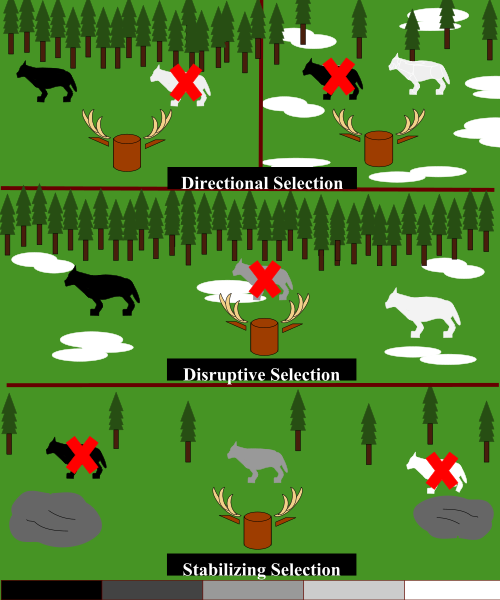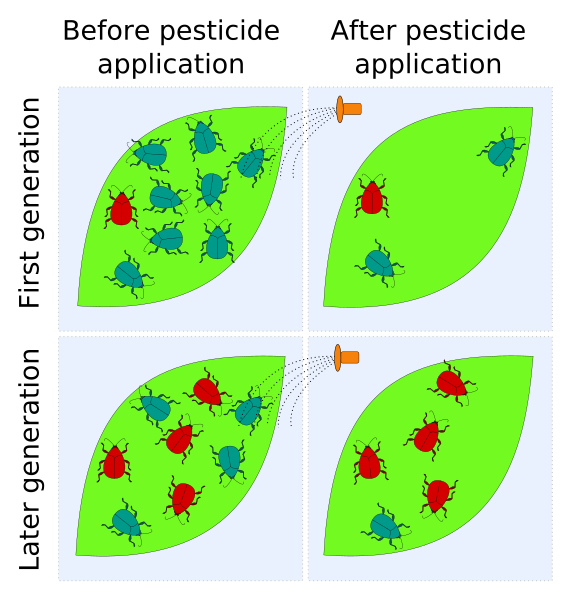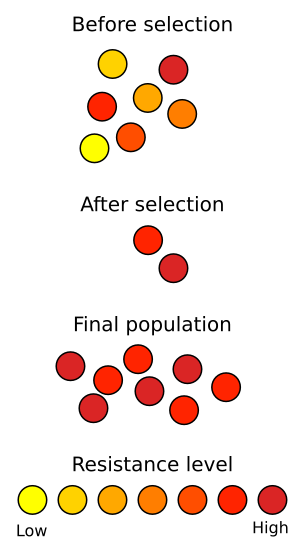OCR Specification focus:
‘Explain how genetic variation, selection pressures and differential reproductive success change populations over time; include pesticide and drug resistance.’
Natural Selection in Populations and Human Implications
Natural selection drives evolutionary change within populations, shaping adaptations that enhance survival and reproduction. It underpins how species evolve and explains modern examples like antibiotic and pesticide resistance.
Genetic Variation: The Foundation of Natural Selection
Natural selection acts on genetic variation within a population — the differences in alleles and genotypes among individuals.
Genetic Variation: Differences in DNA sequences among individuals of the same species, leading to distinct phenotypes.
Sources of genetic variation include:
Mutation – Random changes in DNA that create new alleles. Some mutations are neutral or harmful, while others may be advantageous.
Independent assortment and crossing over – Occur during meiosis, producing new combinations of alleles in gametes.
Random fertilisation – The combination of different gametes increases genetic diversity within populations.
Without variation, natural selection cannot occur because all individuals would respond identically to environmental pressures.
Selection Pressures and the Environment
A selection pressure is an environmental factor that affects the survival or reproductive success of individuals within a population.
Selection Pressure: An external agent that influences which individuals in a population survive to reproduce.
Examples of selection pressures include:
Predation – Individuals better camouflaged or faster are more likely to survive.
Climate – Temperature, rainfall, and seasonal changes can favour certain traits.
Competition – For food, mates, or territory; individuals with advantageous traits outcompete others.
Disease – Resistance to pathogens can determine survival.
Selection pressures act on phenotypic variation — observable characteristics — which are often influenced by underlying genetic differences.
The Process of Natural Selection in Populations
Natural selection operates over generations through a sequence of key steps:
Variation exists within the population due to differences in alleles.
Selection pressures act on individuals, giving those with advantageous traits a survival or reproductive advantage.
Differential reproductive success occurs — individuals with beneficial alleles reproduce more successfully.
Inheritance of advantageous alleles increases their frequency in the gene pool.
Over time, the population evolves, becoming better adapted to its environment.
This process leads to a shift in allele frequencies, the defining feature of evolution.
Evolution: The change in allele frequencies in a population over successive generations.
Populations evolve, not individuals. An individual’s characteristics are fixed at birth, but allele frequencies within the population can change through generations.
Types of Natural Selection
There are three primary patterns of natural selection that influence population structure:

Diagram contrasting stabilising, directional, and disruptive selection and their effects on phenotype distributions in a population. The curves illustrate how selection shifts or narrows trait frequencies over generations. Extra context such as the wolf colour example may appear on the source page but is not required for OCR. Source.
Stabilising selection – Favours the average phenotype, reducing variation. Common in stable environments.
Directional selection – Favours one extreme phenotype, shifting the population mean in one direction.
Disruptive selection – Favours both extremes, potentially leading to speciation if groups become reproductively isolated.
Each type alters genetic diversity differently, depending on environmental stability and change.
Evolution of Resistance: Pesticides and Drugs
Human activity provides strong, artificial selection pressures. Two critical examples in OCR Biology are pesticide resistance in insects and antibiotic resistance in bacteria.
Pesticide Resistance in Insects
Populations contain genetic variation, including alleles conferring resistance.
When pesticides are applied, susceptible insects die, while resistant individuals survive and reproduce.

Diagram of the evolution of pesticide resistance: repeated applications kill susceptible insects, increasing the proportion of resistant phenotypes in the population. This directly illustrates allele frequency change under a consistent selection pressure. The figure is a labelled SVG with high-resolution PNG previews (e.g., 1956×2048). Source.
The allele frequency for resistance increases.
Over time, the pesticide becomes ineffective as most individuals carry resistance alleles.
This demonstrates directional selection, where one phenotype (resistance) becomes dominant due to a consistent environmental pressure.
Antibiotic Resistance in Bacteria
Mutations in bacterial DNA may produce resistance to a specific antibiotic.

Schematic of antibiotic resistance driven by natural selection: susceptible cells are killed by treatment, whereas resistant cells survive and reproduce, increasing the frequency of resistance alleles. The diagram focuses on the selection step rather than detailed molecular mechanisms. Source.
When exposed, susceptible bacteria are killed, but resistant ones survive and reproduce rapidly.
Asexual reproduction (binary fission) allows rapid spread of resistance alleles.
Horizontal gene transfer between bacteria further accelerates resistance across species.
The result is a population-level adaptation that poses serious medical challenges.
Human Implications of Natural Selection
Natural selection continues to influence human populations and global ecosystems through direct and indirect effects.
Medical and Agricultural Implications
Antimicrobial resistance (AMR) threatens modern medicine, reducing the effectiveness of antibiotics.
Overuse and misuse of antibiotics create strong selection pressures favouring resistant strains.
Integrated pest management (IPM) and crop rotation are used to slow pesticide resistance in agriculture.
Maintaining genetic diversity in crops and livestock increases resilience to diseases and environmental changes.
Conservation and Evolutionary Understanding
Understanding natural selection informs conservation strategies:
Small or isolated populations may lose genetic diversity, reducing adaptability.
Conservation programmes aim to maintain genetic variation to ensure long-term survival and evolutionary potential.
Knowledge of natural selection helps predict how species might respond to climate change and habitat alteration.
The Continuing Role of Natural Selection
Even in modern human societies, natural selection operates subtly:
Genetic traits influencing disease resistance, metabolism, or fertility can affect reproductive success.
The spread of lactose tolerance and malarial resistance (sickle-cell trait) illustrates ongoing evolution in human populations.
Artificial selection, through selective breeding and genetic modification, mirrors natural selection but is guided by human choice.
Natural selection remains the fundamental mechanism driving adaptive evolution, shaping life from bacteria to humans and continuing to influence the biosphere under the pressures of a changing world.
FAQ
In natural environments, selection pressures come from ecological factors such as predators, disease, and climate. These pressures act randomly on traits that already exist in the population.
In artificial environments, humans impose selection pressures deliberately, such as choosing high-yield crops or livestock with desirable traits. Natural selection leads to adaptation, while artificial selection leads to domestication and often reduced genetic diversity.
Small populations are more affected by genetic drift, meaning allele frequencies can change quickly by chance.
When a strong selection pressure exists, beneficial alleles can become fixed faster because there are fewer individuals competing and fewer alleles overall. However, small populations also risk losing genetic diversity, which may reduce their long-term adaptability to new environmental challenges.
Not always. Some harmful alleles persist because:
They are recessive, and remain hidden in heterozygous individuals.
They may provide a heterozygote advantage (e.g., sickle-cell allele gives malaria resistance).
Mutation or gene flow may reintroduce them into the population.
Therefore, while selection reduces the frequency of harmful alleles, it rarely eliminates them entirely.
Gene flow—the movement of alleles between populations through migration or interbreeding—introduces new genetic variation.
It can counteract the effects of selection by:
Introducing alleles that are not adaptive in the local environment.
Increasing overall genetic diversity, which enhances adaptability.
In isolated populations, low gene flow can lead to distinct evolutionary paths and potentially new species formation.
Bacteria reproduce rapidly through binary fission, allowing beneficial mutations to spread quickly.
They can also exchange genetic material through horizontal gene transfer using plasmids, meaning resistance can spread even between unrelated species.
This combination of high reproduction rate and gene sharing enables bacterial populations to evolve resistance far faster than multicellular organisms, making antibiotic management a major global health challenge.
Practice Questions
Question 1 (2 marks)
Explain what is meant by differential reproductive success in the context of natural selection.
Mark scheme:
1 mark: States that individuals with advantageous alleles are more likely to survive and reproduce.
1 mark: States that these advantageous alleles are passed on to the next generation, increasing in frequency within the population.
Question 2 (5 marks)
Antibiotic resistance in bacteria is an example of evolution by natural selection.
Describe how antibiotic resistance develops and spreads in a bacterial population.
Mark scheme:
1 mark: Mutations occur randomly in bacterial DNA, sometimes producing alleles that confer resistance to an antibiotic.
1 mark: When antibiotics are used, susceptible bacteria are killed while resistant individuals survive.
1 mark: Resistant bacteria reproduce asexually (by binary fission), passing on the resistance allele to offspring.
1 mark: The frequency of resistance alleles increases in the population over time.
1 mark: Horizontal gene transfer (e.g., via plasmids) can spread resistance genes between different bacterial species.

